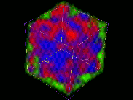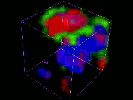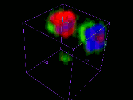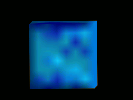
Stefan Thurner
Department of Electrical and Computer Engineering, Boston University
M.C. Feurstein
Department of Electrical and Computer Engineering, Boston University
Institut fur Kernphysik, Vienna , Austria
H. Markum
Institut fur Kernphysik, Vienna , Austria
There is a spring-like force in the vacuum existing between quarks that binds them together into observable bound states. Our research shows that the cause of this force is structure in the vacuum. Excitations of the vacuum can cause it to manifest various physical features, such as magnetic charge (e.g., monopoles). Other features exist just for an instant in 4D Euclidian space-time (e.g., instantons). The vacuum is also characterized by quark/antiquark creation/annihilation, which can not be observed directly.
We perform a mutual analysis of the topological and chiral vacuum structure of four-dimensional quantum chromodynamics on the lattice at finite temperature. Concerning the topological sector, correlation functions between the distributions of color magnetic monopoles in maximum abelian gauge and the densities of the topological charge are computed. An enhanced probability for monopoles inside the core of an instanton is found on gauge field average and in specific configurations. In the chiral sector, clear evidence is found that monopole loops and instantons are locally correlated with the quark condensate.
Video Sequences
In the video sequence, a time slice of a typical configuration with dynamical quarks on the 8^3×4 lattice in the confinement phase is shown. The positive instanton density is denoted by colors in the blue range and the negative density by colors in the red range. Quark-anitquark density is shown in green. This work shows that there is enhanced virtual quark activity at the locations of instantons.
Still Images

Cooling Step 0 – No discernible structure.

Cooling Step 5 – Clusters of non-zero charge density and quark condensate are resolved.

Cooling Step 10 – Topological charge and chiral condensate begin to die out.

Cooling Step 15 – Topological charge and chiral condensate continue to die out and eventually vanish.
Paper
revised2z.ps with color images at bilder.ps
Hardware: SGI Power Challenge Array and SGI Origin2000.
Software: Fortran 77, MPI. Visualization done with AVS.
Graphics programming and video production: Kathleen Curry, Scientific Computing and Visualization Group, Boston University.
Acknowledgments: T. Schafer and E. Shuryak for reviewing the 3-D images, E.M. Ilgenfritz, M. Muller and W. Sakuler for clarifying discussions. This work was partially supported by FWF.

